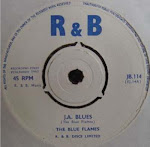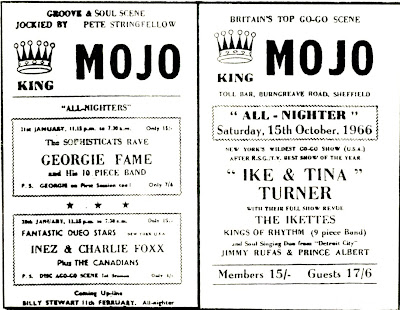John Lee Hooker 1964
Contrasting reviews
John J. Broven
The incredulous, it seemed, had happened when it was announced that John Lee Hooker was to tour
It was not to be.
Hooker started his tour on Monday, June 4th at the Flamingo Club, after a perfunctory appearance at the Rediffusion Studios on “Ready Steady Go!”.
In the broiling atmosphere of this one-time modern jazz centre, we had a full two hours of synthetic rubbish from the Cheynes and John Mayall’s Bluesbreakers.
It was then learnt that Mayall would back Hooker, and despite protests to John Lee before the show, it was to be. Hooker appeared, and with Mayall’s organ and harmonica (yes! – he plays both at once!) striving for the limelight, he was content to strum his way through meaningless things like “Dimples”, “Boom Boom”, “Hi Heel Sneakers” and others.
In his whole act he only did two slow blues and of these, only “I’m In The Mood” came off to any degree. But most disappointing was that his guitar work was kept to a minimum.
Undaunted, I saw Hooker twice later in the tour at
Apart from a magnificent “Late Hours At Midnight” at
What went wrong?
Why was one of the greatest living bluesmen transformed into an unexceptional R&B artist?
 Obviously a lot of blame must go to whoever teamed Hooker with Mayall.
Obviously a lot of blame must go to whoever teamed Hooker with Mayall.
If he must have a group, OK, but not an organ! Also John appeared to be under the misconception that he was playing to a “pop” audience, judging by the stream of medium-tempo songs – which soon began to pall, being so alike.
Blues enthusiasts were definitely to the fore at the Flamingo, and if this wasn’t so elsewhere, wasn’t this the perfect opportunity to educate the uninitiated?
My opinion of Hooker has not fallen on account of this tour.
He has shown, in odd flashes, what a great bluesman he is. It’s just that this tour, for a blues lover, has been so badly presented, if financially a great success.
Simon A. Napier
If you happen to feel like writing, by all means do.
It may be worth mentioning that John, Mike Leadbitter, Graham Ackers and yours truly took JLH along on June 2nd to “
Whatever, this could have had some effect on his act, seeing the audience reaction to Chuck.
Hooker is a fine man, but he is very aware of any commercial angles and willing to put them to good use if it turns out to his benefit
From Blues Unlimited – August 1964 issue
________________________________________________
… and another view from Graham Ackers from the September issue …
Cleveleys, Nr. Blackpool 8/7/64
Wednesday, July 8th. John Lee Hooker played a most unlikely sounding venue at the Savoy Ballroom, Cleveleys. About 8.30 Dave Ward and I emerged from the bar and heard the last few numbers of the Groundhogs set. This group, previously unknown to us, was quite a surprise. They weren’t bad at all and instrumentally very like the originals.
Later they accompanied Hooker.
Then followed some noisy group of ruffians, who, after two verses of “What’d I Say” drove us barwise again!
We re-emerged slightly more amicable in frame of mind, soon dispelled by Georgie Fame and his mob. Admittedly they are technically quite adept, but what a bore the whole thing is!
We even had a Negro bashing some tom-toms, contributing less than nothing (!) – meant to add authenticity I suppose.
After this aural torture, Hooker came on to a very enthusiastic reception.
The message seems to have permeated to the far, windy shores after all.
He rolled straight into “Shake It Baby” with great power – perhaps a little too much – as a string broke after two verses!
Anyway, true to the maxim of all good showmen, he finished the number to great applause.
The next number he played with a Groundhog Fender – a somewhat unusual sight.
The Groundhog repaired his Gibson and finished the number with it.
Many followed including “Night Time Is The Right Time”, “Boom Boom”, “Hi Heel Sneakers”, “Dimples” (twice) and a blue version of “
Every number was received with enthusiasm to such a degree that five encores were performed in all.
A special mention for the Groundhogs who throughout played admirably. All in direct contrast to the “let’s see who can play loudest” approach of John Mayall and crew.
In fact everything was just right – atmosphere, backing, amplification and temperature (compared to Tropical Flamingo conditions) and everybody, including Hooker and the Hogs, had quite a ball.
________________________________________________John Lee Hooker – returned later that year for another tour …






